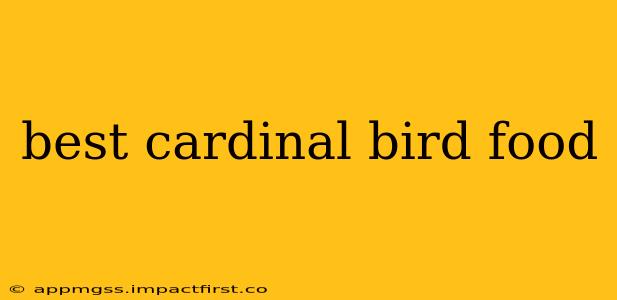The vibrant red of a Northern Cardinal is a welcome sight in any backyard. Attracting these beautiful birds requires providing them with the right food. This guide explores the best cardinal bird food options, answering frequently asked questions to help you create a thriving cardinal feeder station.
What is the best food to attract cardinals?
Cardinals are granivores, meaning their diet primarily consists of seeds. While they'll occasionally eat insects and berries, the best way to lure them to your yard is by offering high-quality seeds. Black oil sunflower seeds are widely considered the best choice. They're high in oil, providing cardinals with ample energy, and their shells are relatively thin, making them easy for the birds to crack. Other excellent options include:
- Safflower seeds: These are another excellent choice, particularly if you want to attract cardinals without attracting other seed-loving birds like squirrels or doves. Cardinals readily consume them, but many other species find them less appealing.
- Nyjer (thistle) seeds: While not their absolute favorite, cardinals will readily consume nyjer seeds, especially during harsh winters when other food sources are scarce. These are best offered in specialized feeders that prevent waste.
- White-striped sunflower seeds: These are a slightly cheaper alternative to black oil sunflower seeds, but they may be less appealing to cardinals.
Avoid cracked corn or mixes with fillers like milo or wheat; these often go uneaten by cardinals.
What kind of bird feeder is best for cardinals?
The type of feeder you use can significantly impact your success in attracting cardinals. Several options work well:
- Tube feeders: These feeders hold a large quantity of seed and often feature multiple feeding ports, allowing several birds to feed simultaneously. Look for tube feeders with perches to accommodate cardinals' size and feeding habits.
- Hopper feeders: These larger feeders offer ample seed storage and are less susceptible to weather conditions. They typically have large openings, accessible to cardinals.
- Platform feeders: These open feeders are great for various birds, including cardinals. However, they're also more vulnerable to seed waste and visits from larger animals.
No matter what type you choose, ensure it’s sturdy, weather-resistant, and easily cleaned to prevent the spread of disease.
Do cardinals eat suet?
While cardinals are primarily seed-eaters, they may occasionally sample suet, especially during the winter months when natural food sources are scarce. Suet is high in fat and provides essential energy. However, it shouldn't be considered a primary food source for attracting cardinals; prioritize seeds instead.
What fruits and berries do cardinals eat?
While seeds form the bulk of a cardinal's diet, they also supplement their food intake with various fruits and berries. They particularly enjoy:
- Dogwood berries
- Sumac berries
- Holly berries
- Mulberries
- Raspberries
- Blackberries
Planting these berry-producing shrubs and trees in your garden can provide a natural food source and further enhance your chances of attracting cardinals.
What do baby cardinals eat?
Baby cardinals are fed primarily by their parents, who provide them with insects and seeds. The parents will regurgitate the food for their young, delivering a mixture of softened seeds and insects rich in protein, which is crucial for their growth and development. You should never attempt to feed baby birds directly unless you are a licensed wildlife rehabilitator.
How often should I refill my cardinal feeder?
The frequency of refilling your feeder depends on several factors, including the number of birds visiting, the size of the feeder, and the weather conditions. Regularly monitor your feeder and refill it as needed. Aim to never let the feeder completely empty, especially during cold weather when food sources can be scarce.
By providing high-quality seeds in the right kind of feeder and supplementing with berry-producing plants, you’ll significantly improve your chances of attracting and enjoying these stunning birds in your backyard. Remember consistent feeding is key to building a relationship with your feathered friends and establishing a reliable food source for them year-round.
